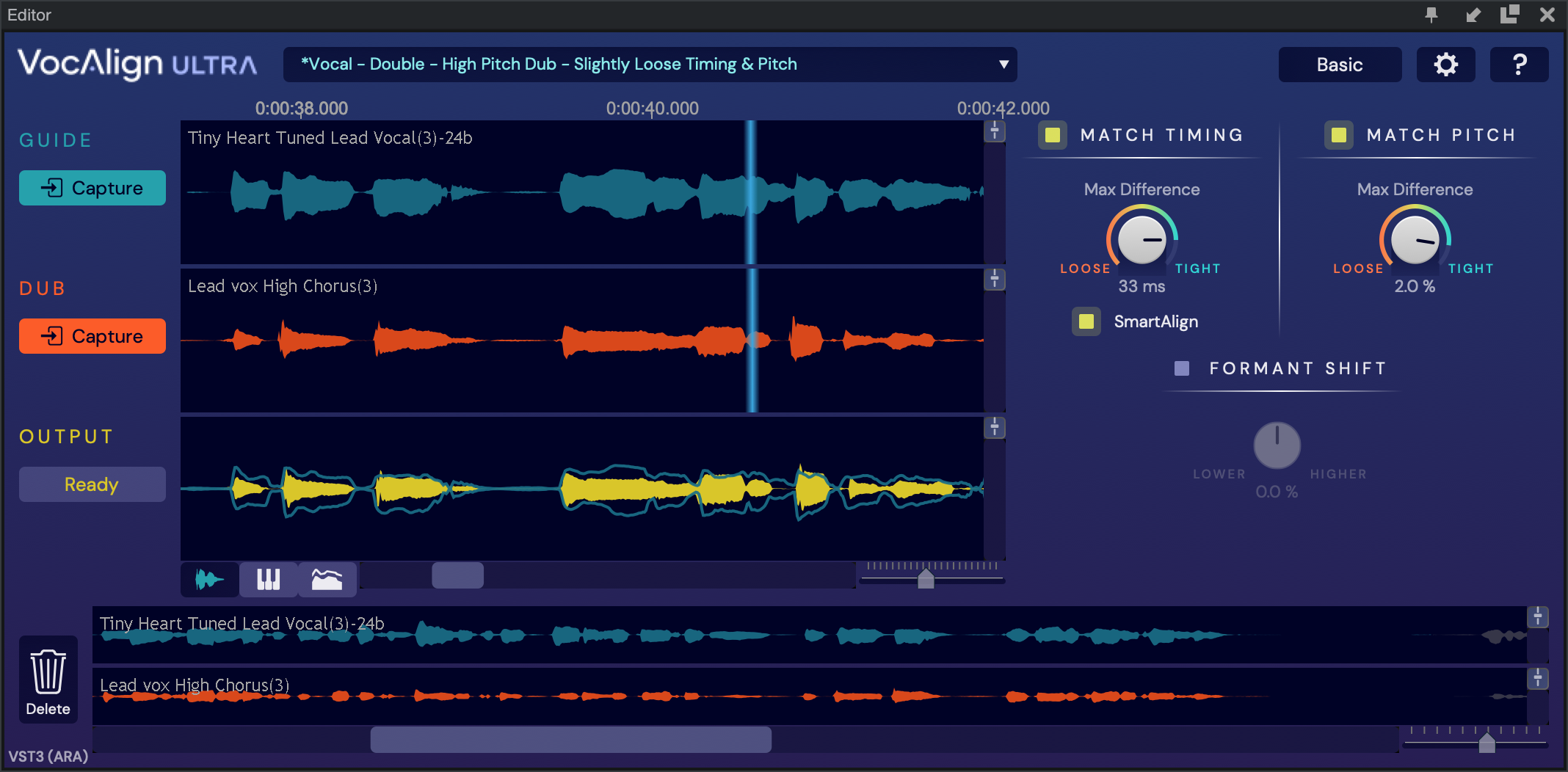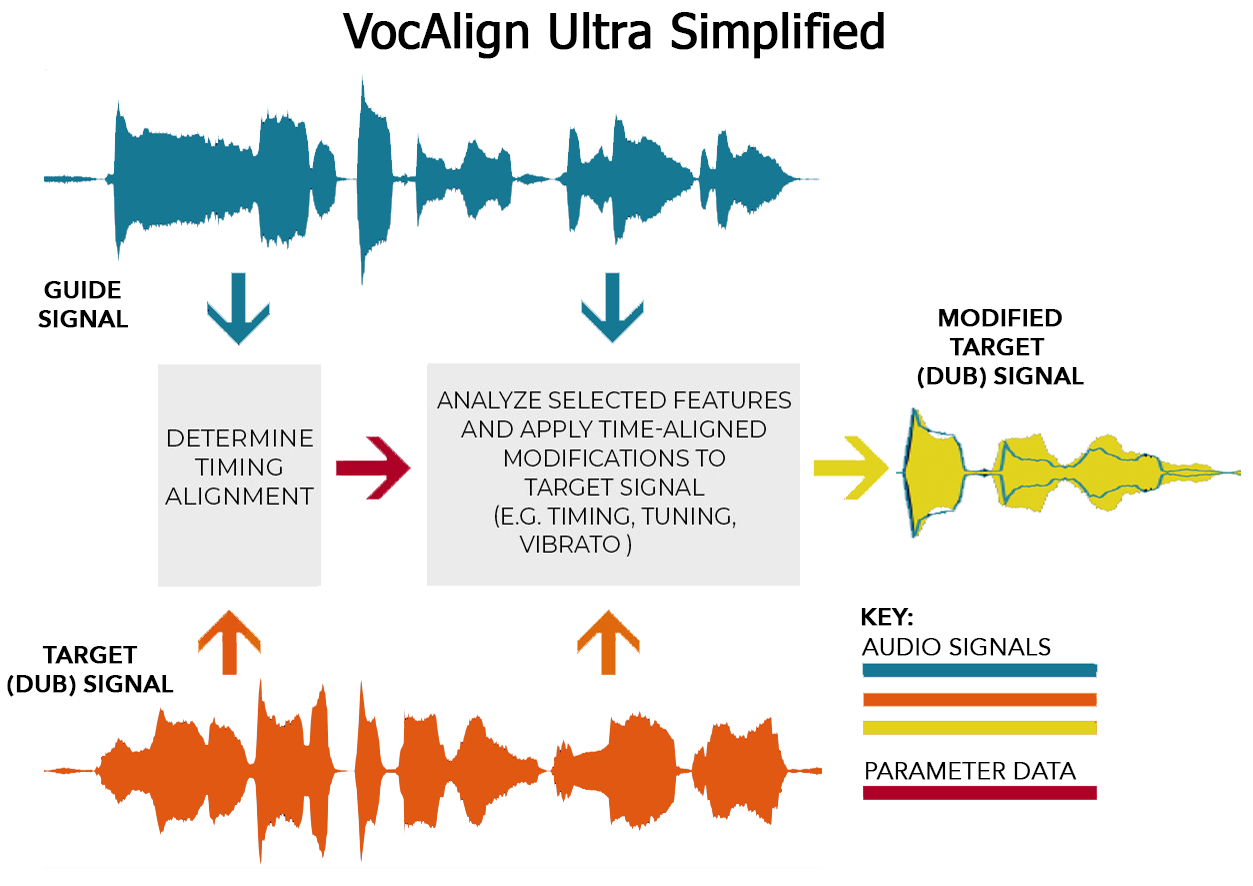What is VocAlign Ultra?
- Introduction to VocAlign Ultra
- What's New?
- What does VocAlign Ultra do?
- Main Applications
- How does it work?
Introduction to VocAlign Ultra
VocAlign Ultra is a powerful but easy-to-use plugin that can automatically match the timing and pitch of one audio signal to the timing and pitch of another audio signal.

What's New?
The main improvement over previous versions of VocAlign Project and VocAlign Pro is the addition of pitch matching and display to the toolbox, drawing on the proven and extensive technology behind Revoice Pro 4, but we’ve also added:
- New in VocAlign Ultra 1.1: A simpler workflow using SmartAlign to automatically align Guide and Dub audio regions.
- A library of presets to help you quickly get the right settings for a variety of jobs and signal types.
- A basic and advanced set of controls to adjust the amount and modes of timing and pitch matching.
- 3 view windows showing waveforms, pitch traces or signal energy displays.
- A movable timing Offset Display showing points of alignment in the Guide and Dub waveforms.
- Improved tools for correcting small issues: Protected Ranges and Sync Points.
- A pitch transpose control.
- A formant control for adjusting the pitch range of resonances.
What does VocAlign Ultra do?
In a nutshell, VocAlign Ultra enables dialogue editors and music producers to quickly and easily align one vocal or instrumental performance with another in the time or pitch domains, or both.
As any dubbing editor or music producer knows, lip-syncing and double tracking vocals and instruments can be a painstaking, laborious process, highly dependent on the ability of the performer to repeat themselves accurately, and often involving many takes to get a workable final result.
With VocAlign Ultra brought into the process, you can let the artist concentrate on creating a great performance, without worrying about the detailed timing mismatches relative to the guide track or pitching imperfections. The plugin automatically and transparently applies the required amount of variable time-stretching and pitch-shifting to match the Dub to the Guide, saving studio and artist time, and delivering natural-sounding results.
Perhaps most importantly, VocAlign Ultra allows your artist to produce their best performance, free from the stressful rigidity and repetition traditionally associated with re-recording or doubling tracks.
Main Applications
VocAlign Ultra can be used for all manner of corrective and creative purposes, including:
In post production:
- Syncing replacement dialogue for film and video.
- Matching the pitch profile and intonation of overdubbed dialogue to the original recording.
- Tightening up lip-syncing with foreign language dubs.
- Changing the vocal timbre or even gender of an actor’s performance.
In music production:
- Double-tracking vocal and instrumental parts.
- Replacing the vocals in a music video shoot with a production track, to achieve perfect lip-sync.
How does it work?
VocAlign Ultra works by applying varying amounts of time-stretching and compression to one signal – the ‘Dub’ – to align its energy peaks and troughs over time with those of a ‘Guide’ signal. It also can modify the pitch of the Dub (whether time-aligned or not) to match the pitch of the Guide.

Audio signal names are coloured to be similar to those in the VocAlign Ultra Interface.
VocAlign Ultra does its processing in three main steps:
- VocAlign Ultra analyzes the Guide and Dub audio signals using identical spectrum analyzers to produce time-varying energy patterns and pitch maps for both signals. Also the time-varying pitch of both signals is measured.
- Advanced pattern recognition techniques are used to compare the two energy patterns and pitch maps, and determine the best way to ‘warp’ the Dub’s timing and pitch (if selected for matching) to align the Dub timing and pitch to the Guide signals. A the time-warping path is created to specifies the best time-distortion of the Dub for matching to the Guide according to the “Matching” tightness setting.
- The time-warping path feeds into an audio editing processor that time-stretches and -compresses the Dub audio signal and, if selected, modify its pitch to the desired tightness, to create the Aligned version.
It is this time and pitch-aligned version of the Dub that is the processed Output, which is returned to the host DAW.